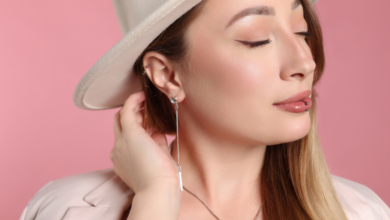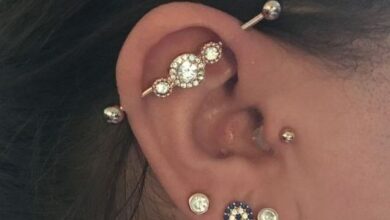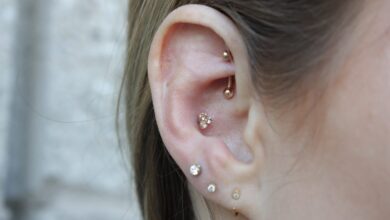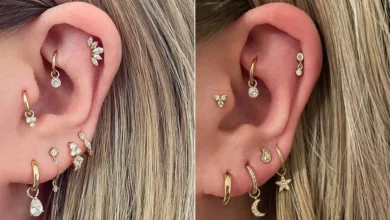
In this article, we’ll discuss the various variations and customization options available for industrial piercings. You’ll learn about the importance of placement on the ear and how it is unique to each person’s anatomy. We’ll also touch upon the cost of the piercing and the factors that can influence it. Additionally, we’ll delve into the crucial topic of aftercare and the potential side effects that can occur. Finally, we’ll provide guidance on when it’s safe to change out your industrial piercing.
Variations and Customization Options for Industrial Piercings
Industrial piercings have gained popularity in recent years, as they offer a unique and edgy way to express personal style. This type of piercing involves two piercings connected by a single piece of jewelry, typically a straight barbell. While the basic concept remains the same, there are several variations and customization options available for industrial piercings. In this article, we will explore different types of industrial piercings, jewelry options, considerations for placement, cost factors, pros and cons, aftercare tips, dealing with common side effects, changing jewelry, getting industrial piercing tips, aftercare products, personalizing industrial piercings, safety and risks, lifestyle considerations, and conclude with a summary of the main points to consider when opting for an industrial piercing.

Types of Industrial Piercings
Traditional Industrial Piercing
The traditional industrial piercing involves two holes pierced horizontally through the upper ear cartilage, with a straight barbell placed through both piercings. This classic style is versatile and can be customized by using different jewelry options and placement variations.
Faux Industrial Piercing
For those who want the look of an industrial piercing without the commitment, the faux industrial piercing is a popular choice. It involves wearing two separate earrings, typically studs or hoops, and arranging them in a way that mimics the appearance of an industrial piercing. This option allows for flexibility and allows individuals to switch up their style easily.
Vertical Industrial Piercing
A vertical industrial piercing is a variation where the two piercings are placed vertically, one above the other, rather than horizontally. This unique placement can create a visually striking and one-of-a-kind look, especially when paired with the right jewelry.
Different Jewelry Options
Choosing the right jewelry is an important aspect of customizing an industrial piercing. Here are some popular options to consider:
Straight Barbell
The straight barbell is the most common and traditional choice for industrial piercings. It consists of a straight bar with beads or decorative ends that screw on at each end. Straight barbells come in various lengths, widths, and styles, allowing individuals to find the perfect fit for their unique anatomy.
Curved Barbell
A curved barbell is a less conventional but equally stylish option for industrial piercings. As the name suggests, the barbell has a slight curve, which can add a more feminine or subtle touch to the overall look. Curved barbells can be a great choice for individuals with specific ear shapes or anatomy.
Circular Barbell
Circular barbells, also known as horseshoe barbells, are semi-circular in shape and have beads or decorative ends that screw on at each end. They can add a unique and eye-catching element to an industrial piercing, especially when strategically placed.
Captive Bead Ring
Captive bead rings consist of a circular ring with a removable bead or ball that locks into place. This style of jewelry can create a minimalist and elegant look for an industrial piercing, allowing the focus to be on the overall design and placement.

Considerations for Placement
The placement of an industrial piercing plays a crucial role in both the overall aesthetic and comfort of the piercing. Here are some factors to consider:
Anatomy and Ear Shape
Individual ear shape and anatomy can vary significantly from person to person. It is important to consult with a professional piercer who can assess your specific features and recommend the best placement for your industrial piercing. They will take into consideration factors such as the size and shape of your ear, as well as any existing piercings or structures that may impact the placement.
Ear Lobe vs. Cartilage Placement
Industrial piercings can be placed either through the cartilage or a combination of the cartilage and the earlobe. If you already have existing cartilage piercings, such as helix or tragus piercings, it may be possible to incorporate them into the design of your industrial piercing. However, it is important to ensure that the placement is comfortable and does not compromise the healing process.
Personal Aesthetic
Ultimately, the placement of an industrial piercing should be a reflection of your personal style and preferences. Some individuals may prefer a more bold and prominent placement, while others may opt for a more subtle and delicate look. Take the time to explore different placement options and discuss them with your piercer before making a final decision.
Cost Factors
The cost of an industrial piercing can vary depending on several factors. Here are the main considerations:
Location of Piercing Studio
The location of the piercing studio can have a significant impact on the cost. Studios in larger cities or more affluent areas tend to have higher prices, while those in smaller towns or less populated regions may be more affordable. It is important to strike a balance between cost and quality when choosing a piercing studio.
Quality and Material of Jewelry
The quality and material of the jewelry used for an industrial piercing can also affect the overall cost. Higher-quality materials, such as titanium or gold, tend to be more expensive than common metals like stainless steel. Investing in high-quality jewelry is crucial for the proper healing and long-term comfort of your piercing.
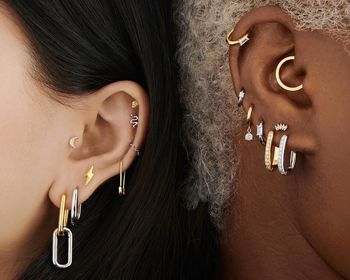
Pros and Cons of Industrial Piercings
Before getting an industrial piercing, it is important to weigh the pros and cons. Here are some advantages and disadvantages to consider:
Advantages of Industrial Piercings
- Unique and visually striking appearance
- Opportunities for customization and personalization
- Ability to showcase individual style and creativity
- Can be easily incorporated into different fashion and style choices
- Can create a sense of empowerment and confidence
Disadvantages of Industrial Piercings
- Longer healing time compared to other ear piercings
- Potential for more pain and discomfort during the healing process
- Risk of infection and other complications if proper aftercare is not followed
- Can be difficult to sleep on the side with the piercing initially
- May not be suitable for individuals with certain ear anatomy or medical conditions
Aftercare Tips
Proper aftercare is crucial for the healing and overall health of your industrial piercing. Here are some essential aftercare tips:
Cleaning and Disinfecting the Piercing
Clean your piercing twice a day using a saline solution or an antiseptic solution recommended by your piercer. Gently clean the area around the piercing, removing any crust or debris. Avoid using harsh cleansers or alcohol-based solutions, as they can dry out the skin and delay the healing process.
Avoiding Irritants and Trauma
During the healing process, it is important to avoid irritants and trauma to the piercing. This includes:
- Avoiding contact with hair products, cosmetics, and perfumes near the piercing
- Avoiding swimming in pools, hot tubs, or bodies of water until the piercing is fully healed
- Avoiding excessive touching, twisting, or playing with the jewelry
- Avoiding tight or restrictive clothing or accessories that can put pressure on the piercing
Recognizing Signs of Infection
It is important to monitor your industrial piercing for any signs of infection. Symptoms of infection may include:
- Increased pain, swelling, or redness around the piercing site
- Unpleasant odor or discharge from the piercing
- Persistent warmth or heat around the piercing
- Fever or chills
If you notice any of these symptoms, it is important to seek medical attention promptly. Early treatment can help prevent the infection from worsening and causing further complications.

Dealing with Common Side Effects
Industrial piercings can sometimes experience common side effects during the healing process. Here are some ways to address these side effects:
Treating Irritation Bumps
Irritation bumps are small, red bumps that can form around the piercing site. They are often caused by irritation or trauma to the piercing. To treat irritation bumps, you can:
- Apply a warm compress to the area to help reduce inflammation
- Clean the piercing regularly to prevent further irritation
- Avoid sleeping on the side with the piercing to minimize pressure and friction
If the irritation bump does not improve or worsens, it is best to consult with a professional piercer or healthcare provider for further guidance.
Handling Piercing Rejection
Piercing rejection occurs when the body views the piercing as a foreign object and starts to push it out. Signs of piercing rejection may include increased visibility of the jewelry, the appearance of a thinning or fading piercing, or the jewelry becoming dislodged easily. If you suspect piercing rejection, it is advisable to consult with a professional piercer or healthcare provider. Depending on the severity, the jewelry may need to be removed, and the area may need to be monitored for infection or scarring.
Managing Infections
Infections can occur if the piercing is not properly cared for or if it is exposed to bacteria or other pathogens. If you suspect an infection, it is important to:
- Clean the piercing daily with a saline solution or an antiseptic solution recommended by your piercer
- Avoid removing the jewelry, as this can cause the infection to become trapped within the piercing
- Seek medical attention if the infection does not improve with proper aftercare or if it worsens
Prompt treatment is essential to prevent the infection from spreading and causing further complications.
Reducing Keloid Scars
Keloid scars are raised, thickened scars that can form around piercings. They are more common in individuals with a predisposition to keloid formation. To reduce the risk of keloid scars, you can:
- Follow proper aftercare instructions provided by your piercer
- Keep the area clean and dry at all times
- Avoid applying any creams or ointments to the piercing without consulting your piercer or healthcare provider
- Seek medical attention if you notice the formation of keloid scars or excessive scarring
Changing Jewelry
Changing out the jewelry in your industrial piercing should only be done after it is fully healed, which can take several months. Here are some tips for changing your industrial jewelry:
Waiting for Full Healing
It is important to wait until your industrial piercing is fully healed before attempting to change the jewelry. Changing the jewelry too soon can cause damage to the piercing and delay the healing process. Your piercer can provide guidance on when it is safe to change your jewelry based on your individual healing progress.
Choosing the Right Size and Style
When changing your industrial jewelry, it is important to choose the right size and style for your piercing. Ensure that the jewelry fits comfortably and does not put excessive pressure on the piercing. Choosing high-quality jewelry made from materials that your body tolerates well can also help minimize the risk of irritation or other complications.

Getting Industrial Piercing Tips
Before getting an industrial piercing, it is important to do proper research and take the necessary precautions. Here are some tips to consider:
Researching Professional Piercers
Take the time to research and find a reputable and experienced professional piercer in your area. Look for reviews, recommendations, and portfolios of their previous work to assess their skill and expertise. Schedule a consultation with the piercer to discuss your ideas and expectations.
Preparing for the Piercing Process
Preparing for an industrial piercing involves taking care of both physical and mental aspects. Here are some things you can do to prepare:
- Ensure that you are in good health and have no underlying medical conditions that may complicate the piercing process.
- Follow any pre-piercing instructions provided by your piercer, such as avoiding certain medications or substances that may thin the blood.
- Mentally prepare yourself for the piercing process. Take deep breaths, listen to calming music, or engage in relaxation techniques to help minimize anxiety or nervousness.
Industrial Piercing Aftercare Products
Using the right aftercare products can make a significant difference in the healing process of your industrial piercing. Here are some essential products to consider:
Antiseptic Solution
An antiseptic solution, such as a benzalkonium chloride-based solution, can be used to clean the piercing site and help prevent infection. It is important to use an antiseptic solution recommended by your piercer, as some products may be too harsh or irritating for healing piercings.
Saline Solution
Saline solution, made by mixing non-iodized sea salt and warm distilled water, can be used to cleanse the piercing and promote healing. It is a gentle and effective option for daily cleansing and can help reduce inflammation and irritation.
Gentle Cleaning Solution
In addition to an antiseptic or saline solution, a gentle cleaning solution specifically formulated for piercings can be used to clean the area around the industrial piercing. Look for a cleaning solution that is alcohol-free and contains mild cleansing agents to avoid drying out the skin.
Personalizing Industrial Piercings
One of the appealing aspects of industrial piercings is the ability to personalize and customize them according to individual preferences. Here are some ways to make your industrial piercing unique:
Adding Charms and Dangles
Adding charms or dangles to your industrial piercing can create a more decorative and visually interesting look. Charms and dangles come in various shapes, designs, and materials, allowing you to express your personal style.
Using Different Colored Jewelry
Jewelry in different colors can add a pop of visual interest to an industrial piercing. Consider using colored gemstones, beads, or even different colored metals to create a customized and eye-catching look.
Mixing and Matching Styles
Industrial piercings can be enhanced by mixing and matching different styles of jewelry. Experiment with different combinations of studs, hoops, barbells, or other types of jewelry to create a unique and cohesive aesthetic.
Safety and Risks
When opting for an industrial piercing, it is crucial to prioritize safety and be aware of potential risks and complications. Here are some important considerations:
Choosing a Reputable Piercer
Selecting a reputable and experienced piercer is essential to ensure a safe and successful piercing. Research piercers in your area, read reviews, and ask for recommendations from trusted sources. A professional piercer should prioritize sterilization and adhere to strict hygiene practices.
Sterilization and Hygiene Practices
Sterilization and hygiene practices are paramount when it comes to industrial piercings. Make sure that the piercing studio follows strict sterilization procedures, including the use of autoclave sterilization for all reusable tools and jewelry. Ask the piercer about their sterilization process and ensure that they use single-use needles and disposable gloves during the piercing.
Potential Risks and Complications
While industrial piercings can be safe and successful when done properly, there are potential risks and complications to be aware of. These may include infection, allergic reactions to jewelry, migration or rejection of the piercing, excessive scarring, or damage to surrounding structures. Following proper aftercare guidelines and consulting with a professional piercer or healthcare provider can help minimize these risks.
Lifestyle Considerations
Before getting an industrial piercing, it is important to consider how it may impact your lifestyle. Here are some factors to think about:
Impact on Sports and Physical Activities
If you participate in sports or physical activities that involve contact or excessive movement, an industrial piercing may require additional care or temporarily restrict participation. It is important to discuss potential limitations and precautions with your piercer to ensure that the piercing does not become injured or irritated during these activities.
Workplace Policies and Dress Codes
Some workplaces may have policies or dress codes that restrict or prohibit visible piercings. Before getting an industrial piercing, consider how it may affect your current or future employment prospects. If necessary, explore options such as clear retainers or concealing jewelry that can make the piercing less noticeable when required.
Conclusion
Variations and customization options for industrial piercings offer individuals a unique way to express their personal style and creativity. From different types of piercings to a wide range of jewelry options, there is something for everyone. However, it is important to consider factors such as placement, aftercare, and potential risks before getting an industrial piercing. By doing so, individuals can enjoy the beauty and individuality of this unique piercing with confidence and safety.
The 16 Types of Ear Piercings: Choosing Based on Pain and Placement(Opens in a new browser tab)
Different Types of Jewelry Options for Nose Piercings(Opens in a new browser tab)
10 Things You Need to Know About Tragus Piercings(Opens in a new browser tab)

